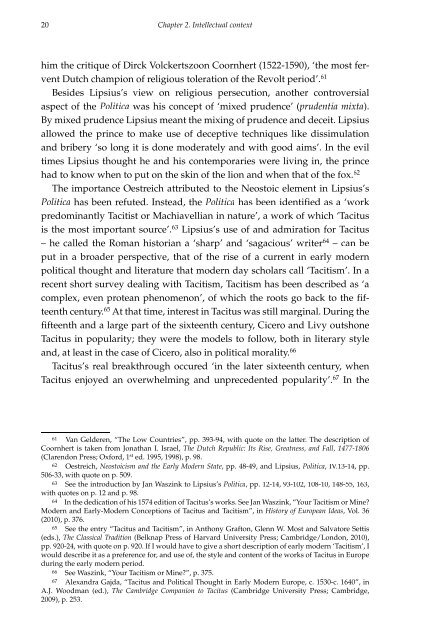historical and political thought in the seventeenth - RePub - Erasmus ...
historical and political thought in the seventeenth - RePub - Erasmus ...
historical and political thought in the seventeenth - RePub - Erasmus ...
Create successful ePaper yourself
Turn your PDF publications into a flip-book with our unique Google optimized e-Paper software.
20<br />
Chapter 2. Intellectual context<br />
him <strong>the</strong> critique of Dirck Volckertszoon Coornhert (1522-1590), ‘<strong>the</strong> most fervent<br />
Dutch champion of religious toleration of <strong>the</strong> Revolt period’. 61<br />
Besides Lipsius’s view on religious persecution, ano<strong>the</strong>r controversial<br />
aspect of <strong>the</strong> Politica was his concept of ‘mixed prudence’ (prudentia mixta).<br />
By mixed prudence Lipsius meant <strong>the</strong> mix<strong>in</strong>g of prudence <strong>and</strong> deceit. Lipsius<br />
allowed <strong>the</strong> pr<strong>in</strong>ce to make use of deceptive techniques like dissimulation<br />
<strong>and</strong> bribery ‘so long it is done moderately <strong>and</strong> with good aims’. In <strong>the</strong> evil<br />
times Lipsius <strong>thought</strong> he <strong>and</strong> his contemporaries were liv<strong>in</strong>g <strong>in</strong>, <strong>the</strong> pr<strong>in</strong>ce<br />
had to know when to put on <strong>the</strong> sk<strong>in</strong> of <strong>the</strong> lion <strong>and</strong> when that of <strong>the</strong> fox. 62<br />
The importance Oestreich attributed to <strong>the</strong> Neostoic element <strong>in</strong> Lipsius’s<br />
Politica has been refuted. Instead, <strong>the</strong> Politica has been identified as a ‘work<br />
predom<strong>in</strong>antly Tacitist or Machiavellian <strong>in</strong> nature’, a work of which ‘Tacitus<br />
is <strong>the</strong> most important source’. 63 Lipsius’s use of <strong>and</strong> admiration for Tacitus<br />
– he called <strong>the</strong> Roman historian a ‘sharp’ <strong>and</strong> ‘sagacious’ writer 64 – can be<br />
put <strong>in</strong> a broader perspective, that of <strong>the</strong> rise of a current <strong>in</strong> early modern<br />
<strong>political</strong> <strong>thought</strong> <strong>and</strong> literature that modern day scholars call ‘Tacitism’. In a<br />
recent short survey deal<strong>in</strong>g with Tacitism, Tacitism has been described as ‘a<br />
complex, even protean phenomenon’, of which <strong>the</strong> roots go back to <strong>the</strong> fifteenth<br />
century. 65 At that time, <strong>in</strong>terest <strong>in</strong> Tacitus was still marg<strong>in</strong>al. Dur<strong>in</strong>g <strong>the</strong><br />
fifteenth <strong>and</strong> a large part of <strong>the</strong> sixteenth century, Cicero <strong>and</strong> Livy outshone<br />
Tacitus <strong>in</strong> popularity; <strong>the</strong>y were <strong>the</strong> models to follow, both <strong>in</strong> literary style<br />
<strong>and</strong>, at least <strong>in</strong> <strong>the</strong> case of Cicero, also <strong>in</strong> <strong>political</strong> morality. 66<br />
Tacitus’s real breakthrough occured ‘<strong>in</strong> <strong>the</strong> later sixteenth century, when<br />
Tacitus enjoyed an overwhelm<strong>in</strong>g <strong>and</strong> unprecedented popularity’. 67 In <strong>the</strong><br />
61 Van Gelderen, “The Low Countries”, pp. 393-94, with quote on <strong>the</strong> latter. The description of<br />
Coornhert is taken from Jonathan I. Israel, The Dutch Republic: Its Rise, Greatness, <strong>and</strong> Fall, 1477-1806<br />
(Clarendon Press; Oxford, 1 st ed. 1995, 1998), p. 98.<br />
62 Oestreich, Neostoicism <strong>and</strong> <strong>the</strong> Early Modern State, pp. 48-49, <strong>and</strong> Lipsius, Politica, IV.13-14, pp.<br />
506-33, with quote on p. 509.<br />
63 See <strong>the</strong> <strong>in</strong>troduction by Jan Wasz<strong>in</strong>k to Lipsius’s Politica, pp. 12-14, 93-102, 108-10, 148-55, 163,<br />
with quotes on p. 12 <strong>and</strong> p. 98.<br />
64 In <strong>the</strong> dedication of his 1574 edition of Tacitus’s works. See Jan Wasz<strong>in</strong>k, “Your Tacitism or M<strong>in</strong>e?<br />
Modern <strong>and</strong> Early-Modern Conceptions of Tacitus <strong>and</strong> Tacitism”, <strong>in</strong> History of European Ideas, Vol. 36<br />
(2010), p. 376.<br />
65 See <strong>the</strong> entry “Tacitus <strong>and</strong> Tacitism”, <strong>in</strong> Anthony Grafton, Glenn W. Most <strong>and</strong> Salvatore Settis<br />
(eds.), The Classical Tradition (Belknap Press of Harvard University Press; Cambridge/London, 2010),<br />
pp. 920-24, with quote on p. 920. If I would have to give a short description of early modern ‘Tacitism’, I<br />
would describe it as a preference for, <strong>and</strong> use of, <strong>the</strong> style <strong>and</strong> content of <strong>the</strong> works of Tacitus <strong>in</strong> Europe<br />
dur<strong>in</strong>g <strong>the</strong> early modern period.<br />
66 See Wasz<strong>in</strong>k, “Your Tacitism or M<strong>in</strong>e?”, p. 375.<br />
67 Alex<strong>and</strong>ra Gajda, “Tacitus <strong>and</strong> Political Thought <strong>in</strong> Early Modern Europe, c. 1530-c. 1640”, <strong>in</strong><br />
A.J. Woodman (ed.), The Cambridge Companion to Tacitus (Cambridge University Press; Cambridge,<br />
2009), p. 253.

















